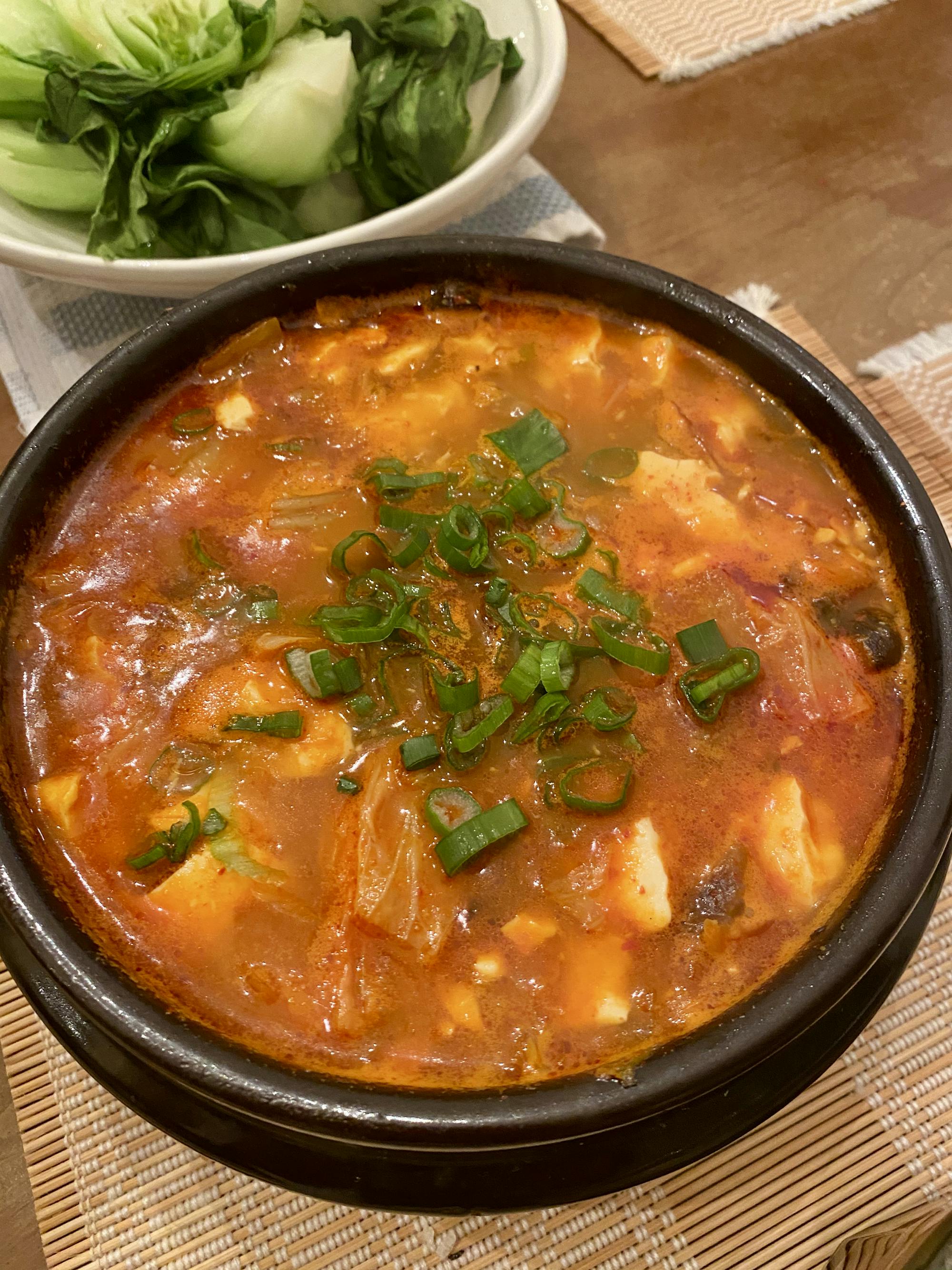Cooking Korean food can be intimidating, especially for a beginner cook. Not only can it be difficult to identify the ingredients necessary for a particular recipe, but figuring out how to use each one can also be intimidating. For those looking for an accessible dish to start with, soondubu jjigae is a great introduction to Korean flavors and ingredients and is especially satisfying at this time of year. While it’s still relatively cold out, I love sipping on this warm and spicy broth and feeling satiated after a meal — without feeling overstuffed. When fresh spring vegetables are not yet available, I often resort to pantry staples to cook my favorite Korean dish, and I urge any beginner cook to explore this dish as well.
Soondubu jjigae can be described as a spicy Korean tofu stew, but that description undersells this addictive dish. Unlike typical stews, it is not thick and heavy. It has a deep umami flavor, seasoned with fish sauce, garlic, scallions and mushrooms. It has a perfect level of spice: spicy in the mouth, but not aggressive on the throat, with a soft, custardy tofu coating the rice and cooling off some of that heat. It’s brothy, but not watery; it’s a hearty meal that feels nourishing.
I learned how to make this dish from a Korean family friend, who emphasizes the need to build flavor throughout the dish. It doesn’t suffice to just throw a handful of red pepper flakes or toss in a can of vegetable stock. It requires a specific layering of flavor that builds upon the funkiness of the kimchi and fish sauce, the spice of the Korean red pepper products and the freshness of thinly sliced scallions. I started cooking this dish in quarantine at the beginning of last spring, and have tested this recipe again and again to fine-tune an authentic taste with the minimum amount of hard-to-find ingredients.
Admittedly, a tasty soondubu jjigae requires some specialty ingredients. For the best result, I highly encourage readers in the Upper Valley to visit Yipings Asian Market, a store down the street from the Hannaford supermarket in West Lebanon. Just an eight minute drive from the Green, at Yipings you will find the gochugaru (red pepper powder), gochujang (red pepper paste), kimchi (spicy fermented cabbage) and fish sauce needed for the recipe. Traditionally, anchovy stock is used for the seafood flavor, but fish sauce adds an equal amount of fishiness. With these ingredients in the pantry, you can cook soondubu jjigae without much meal planning, and if you are interested in Korean cooking in general, these items are great investments for cooking a variety of Korean dishes.
However, there are some substitutes for ingredients that may not be readily accessible. Instead of gochugaru, you could make ground or beaten red pepper flakes — like the ones you find at a pizza restaurant — in a blender, food processor or mortar and pestle. If you cannot find gochujang, add sriracha and a bit of brown sugar to an equal amount of miso paste to replicate that spicy-sweetness. Lastly, in place of fish sauce, you could use equal amounts of soy sauce or miso paste for saltiness and umami.
This dish is easy to make, and does not require special equipment. The kitchenware you will need is simple: essentially, just one medium saucepan or, ideally, a Korean stone bowl that will hold heat very well. The convenient part about this dish is that it is pretty much a one-pot dinner. If making this dish in a dorm room, you could easily find a medium saucepan in the kitchen, and the only cutting needed is of the mushrooms, garlic, and scallions — all of which you could do with a basic knife and cutting board.
To make this a full meal, serve the stew over rice, add a block of ramen noodles at the end of the cooking process or steam up some bok choy, green beans or broccoli on the side. I often eat this dish over a bowl of fluffy rice, runny egg and silken tofu. To make this a proper feast, soondubu jjigae would pair very well with kimchi pancakes, tteokbokki (spicy rice cakes) or fried rice.
Ingredients:
2 servings
2 tbsp. cooking oil (olive or vegetable)
1 tbsp. sesame oil (optional)
4 cloves sliced garlic
1-2 scallions stalks, whites and green separated
½ cup diced kimchi
8 oz mushrooms (shiitake preferred)
2 tbsp. gochugaru
3 tbsp. gochujang
¼ cup kimchi juice
2 cups broth (vegetable) or water
2-3 tbsp. fish sauce
1 pack soft/silken tofu
1 egg
Preparation:
1. Heat a stone pot or medium pot to medium-high heat. Once hot, add cooking oil and sesame oil.
2. Add sliced garlic, whites of the scallions and mushrooms. Saute until soft and mushrooms are slightly brown (two to four mins.).
3. Add diced kimchi, gochugaru and gochujang. Saute until gochugaru is fragrant and kimchi dries up.
4. Deglaze the pot with kimchi juice and stir until evaporated. Add broth/water and fish sauce and bring to a boil.
5. Once boiling, add tofu and simmer on low heat for 10 mins.
6. Add egg and cook until desired consistency (about four to five minutes for a jammy yolk).
7. Garnish with thinly sliced scallion greens and serve over rice!




